6/23/2011
Trials Time
GrowerTalks' Staff
The 2011 edition of the California Pack Trials is “all over but the shoutin’,” as Chris Beytes’ Louisiana-bred father-in-law would have said, and now it’s time to recap the highlights so that you can place your orders for 2012. But first a recap of the event itself:
Size. From an exhibitor number standpoint, this may have been the biggest Trials ever. It’s hard to give an accurate final count, but there were close to 50 different exhibitors when you count all the tag, pot, media and chemical companies that have displays within the plant trials. It’s even higher if you count the individual companies that fall under a larger corporate umbrella—such as the five Agrexco growers, or Ball’s seven plant divisions (plus Wave, Daniels, Ball exclusives …). Did we say Trials were big?
Stops. Thankfully, there weren’t 50 different greenhouses to stop at. Just 18, which is down from a high of 22 or 23 a few years ago. Credit industry consolidation. In the past few years, Benary, Kieft, Ball FloraPlant, Daehnfeldt, S&G and Bodger have all moved in with someone else or gone away.
Seed vs. Vegetative. When the trials started in 1967 at Goldsmith Seeds, they were 100% seed varieties, grown in packs. The first vegetative trials to join the fray were Golden State Bulb Company, Ball FloraPlant (which was an invitation-only trial) and Goldsmith Plants. It was the presence of Proven Winners, Yoder, Paul Ecke Ranch and Van Zanten North America at the trials in 1997 that started the current-day Trials circus.
This year, at our count, just nine seed companies participated out of 32 plant companies. That’s 28%. Somebody asked us to compare the number of seed intros vs. vegetative intros. Our guess would be that less than 20% of the new stuff comes from seed.
Where are the plant exhibitors from?
USA (11), Holland (7), Germany (4), Japan (3), Israel (2), UK (2), Canada (1), Denmark (1), Switzerland (1).
What about actual plant breeders? Nice numbers, above. But what about actual breeding companies, not just those companies that contract with other breeders for exclusive distribution rights? We count 20, located thusly:
Holland (5), Germany (4), Japan (3), USA (3), Israel (2), UK (2), Switzerland (1).
How was attendance? On par with previous years, from what we heard. Syngenta reported 1,300 guests—about the same or up a little from last year. Proven Winners was down by just 100 or so visitors. Ball had 1,400 visitors, and a record day on Tuesday, with 373. GreenFuse reported increased attendance for this, their second trial. And all the important distributors and retailers made the trip. However, there was no big busload of Depot growers and buyers, because they had visited a few weeks earlier for their own private, pre-Spring Trials review.
Next year. March 23-31: put that on your calendar as the official dates for Spring Trials 2012. The late March, Friday-to-Saturday stretch was chosen by a newly formed steering committee—Ball, Proven Winners and Syngenta—in a conference call in May. The dates take into account the usual factors: Easter (April 8), Passover, the European Spring Trials and the start of spring sales for visitors.
Visit the GrowerTalks YouTube channel to see the videos we captured while traveling up the California coast, www.youtube.com/growertalks.
 Most Memorables
Most Memorables
Varieties that were easy to remember days after seeing them—a sure sign of success
1. Calibrachoa Superbells Cherry Star (Proven Winners)—The first star-patterned variety in the popular Superbells series, Cherry Star maintains a sharp yellow star pattern on early blooming flowers. As with the others in the series, it’s ideal for baskets and combos.
2. Mighty ‘Mato grafted tomato (Plug Connection)—Commercial growers reap the benefits of grafted veggies and now homeowners can, too. Introduced under the name Super Naturals, Mighty ‘Mato is a line of grafted tomatoes featuring vigorous, disease-resistant rootstock under popular F1 and heirloom varieties. The result is more diseases resistance and with four to five times the yield. They’re currently looking at adding grafted peppers and eggplant to the mix.
3. Osteospermum 3-D (Selecta)—It wasn’t just the 3-D glasses that were causing the buzz about this new series. These anemone-type osteospermum flowers are the only ones on the market that stay open day and night. All three colors in the 3-D series—Pink, Purple and Silver (pictured)—can be grown cool and don’t require any special culture treatments. No PGRs needed during the bud stage.
4. Field of Dreams ornamental corn (Vegetalis/Floranova)—Complete with baseball diamond, this ornamental corn got the All-Star treatment at Floranova’s Lompoc trials. In just 5 to 6 weeks, Field of Dreams is ready for retail, with stable variegation on the foliage. It grows 4 to 5 ft. tall, but the height is determined by the pot size, said Floranova’s Pete Bradford. It will stay 3 ft. in a gallon container. Grow it dry and easy on the nitrogen. Seed will be priced similar to ornamental millet.
5. Rosa hulthemia Eyeconic (Greenheart Farms)—For the last 50 years, renowned rose expert Ralph Moore worked on a
hulthemia-type rose that would bloom non-stop instead of just once a year, and Greenheart Farms was proud to show us the fruits of his labor. Two different colors in the Eyeconic series, Lemonade and Pink Lemonade, feature a dark center eye and frilled petals with a slight fragrance. However, if you live on the East Coast, don’t fall in love yet—Eyeconic is only being promoted on the West Coast (it doesn’t like humidity). Mr. Moore’s successors continue to work on making these more disease resistant for the rest of the country, along with developing additional colors.
6. Glamour Red F1 flowering kale (Takii)— This 2011 All-America Selections winner was bred for shiny foliage—they managed to eliminate the dull, waxy coating on other kale. (It’s also suspected that it will be more pest resistant because the foliage is more slippery for the bugs.) The foliage color intensifies with cooler temperatures.
 Industry Innovations
How breeders/distributors are using technology to take business to the next level
1. Ecke Snap System 78
Industry Innovations
How breeders/distributors are using technology to take business to the next level
1. Ecke Snap System 78 (Paul Ecke Ranch)— For the last eight years, Ecke has been working on developing a new way to ship pre-stuck callused cuttings to growers from their farm in Guatemala. With this new 78-count tray system, you get callused cuttings already stuck in “Snap Media,” which means you don’t have to worry about sticking them when they arrive at your greenhouse. Plus it reduces disease losses, and it cuts two weeks from your crop time. Varieties available in the Snap System are all Ecke poinsettias, some geraniums and some of the core spring crops from the Flower Fields program.
2. Trixi 2.0/MixMasters 2.0 (Selecta/Ball FloraPlant)—Ball took the concept of multi-variety liners (a technology now patented by Dümmen) and found a way to root each variety separately before combining them in a shamrock-shaped final cell for finishing. This provides the added benefit of being able to treat individual varieties uniquely (timing, PGRs or pinches, for instance) and lets them grade before final sticking, eliminating blind corners in the finished liners. Plus, they can now combine seed and vegetative varieties, grasses … pretty much anything that grows. Trixi 2.0 now has 19 total blends; the new MixMasters 2.0 is being introduced with 15 mixes.
3. Augeo PGR (OHP)—“Growers should be looking at Augeo.” Those were the simple but weighty words to us from Dr. Jim Barrett, one of the world’s leading authorities on plant growth regulators. Why? “It changes the architecture of the plant,” explained OHP’s Dennis Kern. Not a normal PGR, Augeo works more like Florel … but with a 4-hour REI. They’re researching its many possible applications now, but they know it works great on calibrachoa, petunias, verbena, fuchsias and more. Their recommendation: treat plugs just before transplanting with 400 to 800 ppm (800 to 1,600 ppm for woodier plants).
4. Genesis program (Ball FloraPlant)—This new option allows growers to order callused cuttings of geranium and osteospermum, direct stick them and have them ready within eight weeks. There’s less loss due to disease. Plus Ball FloraPlant grades the callused cuttings before shipping, aiding uniformity. There’s no transplanting after rooting, reducing labor and bench time in the greenhouse.
5. QR codes/Social Media (a plethora of companies) The whole smartphone technology/social media hoopla is coming on strong in horticulture. Many of the companies on the trials circuit featured marketing programs that took advantage of today’s tech tools to help consumers better understand their products. We saw QR tags on labels and pots, in catalogs and on signage. Proven Winners has more than 30,000 friends on their Facebook page. The Burpee Garden Coach app now includes Burpee’s new annuals line. Hort Couture is the first one to put the Facebook logo on their pots, Benary featured QR tags on their POP … The list gets longer and longer every year.
6. Plants in a Jiffy (Jiffy)—Introduced as just a concept at last year’s Spring Trials, Jiffy’s answer to the veggie trend is now in larger 4-in. Jiffy pots packed in an easy-to-handle six-pack “beer”-style carrier. Jiffy is also working on including annuals in the program, but the veggie concept is exclusive to IGCs.
New Series
Stand-along introductions are fine, but we like to see whole new series. Here are some of them:
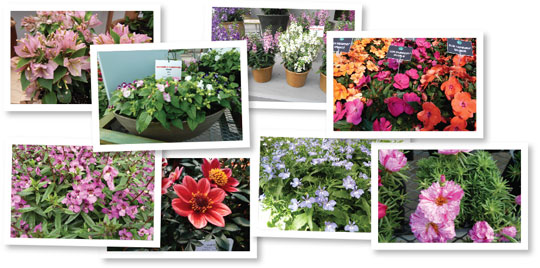 1. Sunvillea Bougainvillea
1. Sunvillea Bougainvillea (Suntory)—Chris saw this new series when it won the Best New Flowering Plant Award at January’s Tropical Plant Industry Exhibition (TPIE). Extremely compact, it’s very early to bloom—from a 72-cell liner Sunvillea begins to flower within just a few weeks. The three colors in the series are Rose, Pink and Cream.
2. Torenia Kauai series (PanAmerican Seed)—This upgrade from the Clown series includes six bright colors and a mix that feature a tight flowering window. These plants have lots of consumer appeal because of the amount of blooms and the versatility to grow almost anywhere. A great shade plant, the Kauai series will take the sun in humid climates.
3. Angelonia Archangel (Ball FloraPlant)—Angelonia isn’t normally known for big flowers, but Ball is hoping to change that with this new series that features quarter-sized blooms. Although the flowers are large, the plant itself maintains a compact habit. Four colors: Purple, Pink, Raspberry and White.
4. Sun Harmony New Guinea Impatiens (Danziger)—The name says it all. Trialed in Israel for the last three years, this new series is being marketed as a full sun New Guinea. Compact with large flowers, the series starts with four colors: Magenta, Salmon, Purple and Orange.
5. Angelonia Sungelonia (Suntory)—With a more uniform habit across the series, these plants are a bit more compact than comparable varieties, and are earlier to flower in spring, being ready to go by Mother’s Day. Colors include White, Deep Pink and Blue.
6. Dahlias Happy Day (GroLink)—Dark-leafed varieties that are slightly smaller than the Happy series, these new intros come in four colors: Pink, Red, Cream and Purple.
7. Lobelia California (Cohen)—An upright and heat tolerant series that includes six different colors with extended flowering during short days.
8. Portulaca Happy Hour (PanAmerican Seed)—Another new series for the heat, Happy Hour’s photoperiod is only about 10 ½ hours, which means you can sell it about two weeks earlier than other series. With eight vivid colors (no pastels) it will take the place of the older Margarita series.
 9. Osteospermum Margarita Nano
9. Osteospermum Margarita Nano (Fides)—It seems to be the year of the compact plant for Fides, who introduced another nicely mounded series—this one comprising of six new osteospermum colors that work great in their new Party of 6 program (more on that later).
10. Begonia Whopper (Ball Seed)—Available exclusively from Ball Seed, this fibrous begonia boasts extremely large flowers that are up to 3 in. (7 cm) across. All five colors are vigorous, heat tolerant and ideal for mass plantings and large containers.
11. Geranium Precision (Ball FloraPlant)—On the ivy geranium side, Ball FloraPlant is replacing the Colorcade series with Precision. Named for its habit and flowering time, you can fill a 12-in. basket with just three cuttings and one pinch. There are 14 colors in the series, including Red Ice, which is the stand-out of the bunch.
12. Geranium Presto (Ball FloraPlant)—Ball is replacing the Showcase series with a series of 13 new zonal geraniums that Jim Kennedy said will send up three initial flower heads on each plant, for an impressive show of color. Compact and uniform, these dark-leafed varieties don’t require any PGRs.
13. Osteospermum Akila (PanAmerican Seed)—From seed, not cuttings, the three colors in this new series have an 85% yield potential, the highest currently on the market. It’s ready 12 weeks after sowing. Colors are White, Purple and Lavender Shades and a mix.
14. Begonia Yin/Yang (Ball Seed)—These two well-matched series are identified by their foliage color. Yin is the bronze-leafed series; Yang is the green leafed (the “g” in Yang will help you remember green). Both are up to two weeks earlier than others on the market and are very heat tolerant.
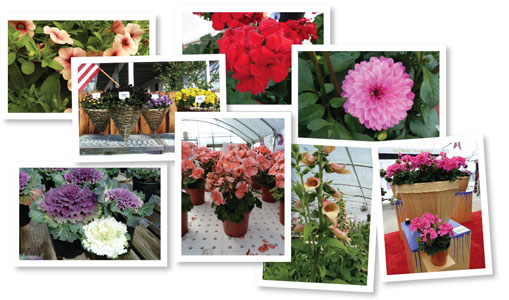 15. Calibrachoa Kimono
15. Calibrachoa Kimono (Hort Couture)—All you had to do was look for the Japanese kimono hanging over this new calibrachoa series to find it. Inspired by the Land of the Rising Sun, the five varieties have slightly larger flowers than typical calibrachoa. Plus, Hort Couture has developed eye-catching POP to complement the series at retail. Colors are Blue Dragon, Kim Chi, Koi, Obi Lavender and Tokyo Sunset.
16. Pansy Freefall (Floranova)—This trailing pansy series offers a vigorous, spreading habit with medium-sized flowers, making them ideal for pack sales, baskets and containers. And it’s good for summer production because it’s less prone to stretching. Comes in five colors and a mix.
17. Geranium Cumbia and Salsa (Dümmen)—Two new interspecific geranium series, each with two colors. Cumbia has double flowers in Hot Pink and Dark Red, while Salsa features single flowers in Pink and Dark Red. Both series are good for a wide range of pot sizes.
18. Dahlia XXL (Dümmen)—As the name describes, these flowers are BIG—we measured them from 4 to 6 in. (11-15 cm) across. All nine colors have festive Spanish names and are suitable for mixed and solo containers.
19. Flowering Kale Song Bird F1 (Takii)—More compact than the Pigeon series, the three colors in Song Bird are well matched for uniformity with loads of upright leaves that help to drain rainwater better. In cooler conditions, the colors intensify.
20. Geranium Nano F1 (Hem Genetics)—No PGRs are required for this seed geranium series—it’s naturally dwarf with a non-stretching habit. All five colors are extra-early to flower.
21. Digitalis Polkadot (Thompson & Morgan)—These interspecific hybrids produce plants with sterile flowers with a long bloom time. The plants reach a height of 36 in. (100 cm) and have good basal branching. Four colors: Pandora, Princess, Pippa and Polly.
22. Geranium Pop Idols (Fides)—A compact-growing, dark-foliage series that’s ideal for six-packs. Five eye-catching colors provided a nice backdrop to their Hollywood-inspired Spring Trials theme.
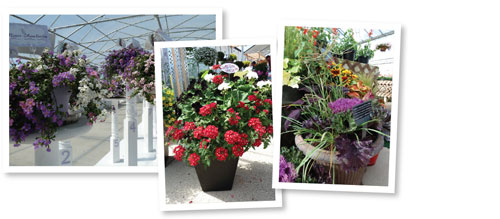 Combination Craze
Combination Craze
Combo programs, plus an intro that is suited specifically for combos.
1. Mixis program (Danziger)—This year, 85% of Danziger’s Spring Trials display was dedicated to their new container program called Mixis. Inspired by fairies, each combination features two or three different varieties. Danziger also offers a “Freestyle” option in which you create your own recipe and they package the individual components for you. There is also POP—pots, tags and signage—for retail.
2. Garden Party (Dümmen)—To complement their Confetti multi-variety liner program, Dümmen is offering a mix of accent and flowering plants that growers can order by number. Diane Surette said that they’re trying to make it easy for growers to produce their own combinations.
3. Flying Stars Chloris (Takii)—This tropical grass may not look that exciting on its own (in fact, we think we’ve pulled some of these from our lawn), but put it in a container with flowering plants and its star-shaped seed heads make an unusual “thriller.” It likes high light from sowing to finish and well-drained soil.
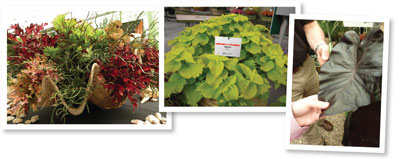 Forgo the Flowers
Foliage so cool, who need blooms?
1. Coleus Under the Sea series
Forgo the Flowers
Foliage so cool, who need blooms?
1. Coleus Under the Sea series (Hort Couture)—This series had the funkiest foliage we’ve ever seen—not just great colors, but shapes that look just like exotic tropical fish. Some of the variety names: Molten Coral, Hermit Crab, Lime Shrimp, Sea Scallop … And best of all, this eight-color series was bred by a group of Saskatchewan, Canada, students as a class project. (They worked for beer money, we joked.)
2. Coleus Wasabi (Ball FloraPlant)—You can spot this foliage plant from across the room because of its vivid chartreuse color. Ball FloraPlant paired it with Redhead coleus to show how they play off of each other. Bred by the University of Florida.
3. Colocasia Black Coral (PlantHaven)—This deep-colored colocasia has glossy foliage with blue veins and grows 36-48 in. (91-121 cm) tall. It provides long interest well into the season and is hardy to Zone 7b.
Marvelous Monikers
As we do every year, we give props to the creative people behind the product names. Some are kooky, some are fun … and some took more than two minutes to explain.
Hosta Wheee! (Proven Winners)—They described the rippled leaves of this hosta as “like a little girl’s ruffled skirt.”
Daylily Primal Scream (Proven Winners)—Loud tangerine with twisted petals.
Party of 6 program (Fides)—Great name for a six-pack program. The plants in these packs are direct stuck, so you have six plants ready for retail in six weeks. Party of 6, your garden is ready!
Bidens 2 Teeth Big Oly Star (GGG)—Wacky name that makes sense. Bidens means “two teeth” in Latin, for the two small teeth on the seed that grab on to passing animals and Latin students.
Petunia Hell’s Bells (Westhoff)—A daring name, but fitting for its bright, bold orange flowers.
Carnation Sunflor Black Money (Fides)—We’re told “black money” in Europe means you didn’t pay any taxes on it.
There were a couple that had us reaching for the candy jar, too...
Calibrachoa Superbells Grape Punch and Sweet Tart (Proven Winners)
Petunia Good ‘N Plenty (GreenFuse)
Petunia Taffy F1 (Ball Seed)
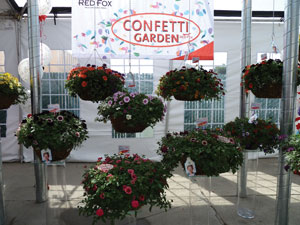 Happy Birthday Confetti
Happy Birthday Confetti
This year, Dümmen was celebrating the Confetti multi-variety liner program’s fifth year, complete with cupcakes, noisemakers and party hats. They also added nine new mixes that include some of their newest varieties.
 Garlic Ice Cream—Yes!, BBQ—No!
Garlic Ice Cream—Yes!, BBQ—No!
While passing through Gilroy, Chris made it a point to stop at Garlic World, since I never had the pleasure of visiting. Besides gazing upon the world-record 216-ft. garlic braid, I was forced, er, I mean asked, to try the garlic vanilla ice cream. Needless to say, it wasn’t as “subdued” as I expected and multiple rounds of tooth brushing and Orbit gum did little to quell the aroma from my mouth. It’s all on video—visit the
GrowerTalks channel on YouTube (
www.youtube.com/growertalks) to see it.
Also, Ellen and I tip our hats to Chris for enduring a week without BBQ—unless you count the tri-tip sliders at Fides. Skeptics said it couldn’t be done, but he held strong and we thank him for not subjecting us with multiple days of BBQ-slathered meals. Here’s a pic of us eating healthy at Dümmen’s trials.
We promise to stop at Brett’s BBQ when we’re in Encinitas next year. I, however, will only be partaking of the trail mix if we go to Garlic World again. My sinuses and breath can only take garlic ice cream once every few years.
—Jen Zurko